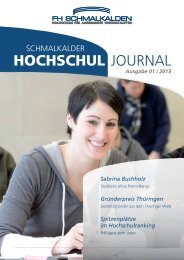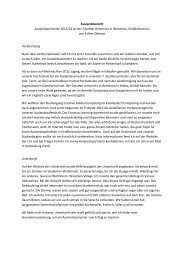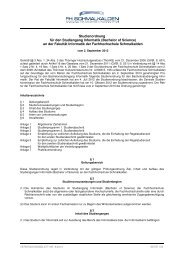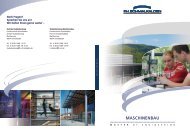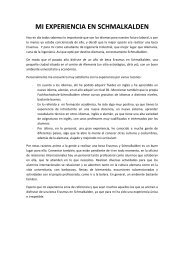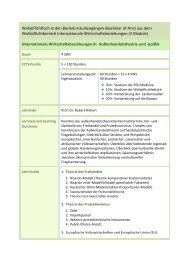Principles of Coating Technology
Principles of Coating Technology
Principles of Coating Technology
You also want an ePaper? Increase the reach of your titles
YUMPU automatically turns print PDFs into web optimized ePapers that Google loves.
GFE Schmalkalden e.V.<br />
<strong>Principles</strong> <strong>of</strong> <strong>Coating</strong> <strong>Technology</strong> II<br />
<strong>Principles</strong> <strong>of</strong> <strong>Coating</strong> <strong>Technology</strong><br />
Part I - Basics<br />
Part II – Deposition methods<br />
6. Painting<br />
7. Electro plating and anodic oxidation<br />
8. Thermal Spraying<br />
9. Build-up Welding<br />
10. Vapor deposition (PVD / CVD)<br />
GFE Schmalkalden e.V.<br />
<strong>Principles</strong> <strong>of</strong> <strong>Coating</strong> <strong>Technology</strong> II<br />
8. Thermal Spraying<br />
1<br />
2<br />
1
GFE Schmalkalden e.V. Thermal spraying<br />
• melting and acceleration <strong>of</strong> metallic or non-metallic material toward to an<br />
substrate<br />
• Surface normally is not molten<br />
• <strong>Coating</strong> adhesion mainly results by mechanical clamping depending on<br />
surface roughness and by adhesive processes<br />
Process scetch<br />
<strong>Principles</strong> <strong>of</strong> <strong>Coating</strong> <strong>Technology</strong> II<br />
Spray gun<br />
Spray material<br />
- powder<br />
- wire<br />
- rods<br />
Heating and<br />
accelerating<br />
Energy source<br />
- flame<br />
- arc<br />
- plasma<br />
substrate<br />
GFE Schmalkalden e.V. Thermal spraying<br />
Formation <strong>of</strong> the coating structure<br />
<strong>Principles</strong> <strong>of</strong> <strong>Coating</strong> <strong>Technology</strong> II<br />
Pore<br />
Oxidized particle<br />
Not melted particle<br />
substrate<br />
• Flowing and overlaying <strong>of</strong> molten<br />
particles<br />
• generation <strong>of</strong> oxides and pores<br />
• Inhomogeneous coating structure<br />
3<br />
4<br />
2
GFE Schmalkalden e.V. Thermal spraying<br />
Application examples<br />
• Steel layers for surface repair<br />
• Ceramic thermal barrier coatings<br />
• corrosion protection <strong>of</strong> components<br />
• Wear protection <strong>of</strong> components<br />
• Hot gas corrosion protection (aircraft turbine blades)<br />
Thermal spraying <strong>of</strong> a shaped<br />
part with a bronze layer<br />
<strong>Principles</strong> <strong>of</strong> <strong>Coating</strong> <strong>Technology</strong> II<br />
Thermal spraying <strong>of</strong> cylinder for the printing<br />
industry<br />
GFE Schmalkalden e.V. Thermal spraying<br />
Application examples<br />
Industry Application areas<br />
Automotive Pistons, cylinders<br />
Chemical industry Valves, punps, storage reservoir<br />
Electrotechnical industry Isolators, conductive layers, capacitor, fuel cells<br />
Consumables Electric irons, fry pan<br />
Engineering Compressors, pumps, cylinders,<br />
Medicine Coated implants<br />
Aerospace industry Run-in layer, thermal barrier coatings, blades, combustion<br />
chamber,<br />
Textile industry Thread eye, thread brake<br />
<strong>Principles</strong> <strong>of</strong> <strong>Coating</strong> <strong>Technology</strong> II<br />
5<br />
6<br />
3
GFE Schmalkalden e.V. Thermal spraying<br />
Surface pre-treatment<br />
Pre treatment absolute necessary for a sufficient coating adhesion<br />
Removal <strong>of</strong> oils, lubricants, paints, oxides and scales<br />
Pre treatment methods:<br />
• Removal <strong>of</strong> coarse contamination: grinding, turning, …<br />
• Degreasing <strong>of</strong> the substrate: dissolvent bath, steam cleaning, ultrasonic cleaning, …)<br />
• Blast cleaning for an increased surface roughness (important: removal <strong>of</strong> blasting material)<br />
Objective <strong>of</strong> pre-treatment: improvement <strong>of</strong> surface energy (surface activation)<br />
<strong>Principles</strong> <strong>of</strong> <strong>Coating</strong> <strong>Technology</strong> II<br />
GFE Schmalkalden e.V. Thermal spraying<br />
Spray material<br />
• Powder, rods, wires<br />
• Hard metals and alloys<br />
• Powder size 1 mm … mm<br />
<strong>Principles</strong> <strong>of</strong> <strong>Coating</strong> <strong>Technology</strong> II<br />
Hard material<br />
Metallic hard material Non metallic hard material<br />
Hard metal Hard alloy<br />
7<br />
8<br />
4
GFE Schmalkalden e.V. Thermal spraying<br />
Classification <strong>of</strong> thermal spay methods<br />
Heat generation by combustion<br />
• Flame spraying<br />
• Detonation spraying<br />
• High velocity oxygen fuel (HVOF)<br />
20<br />
15<br />
10<br />
<strong>Principles</strong> <strong>of</strong> <strong>Coating</strong> <strong>Technology</strong> II<br />
process temperature<br />
Prozesstemperatur [1000 °C]<br />
5<br />
0<br />
0<br />
Lichtbogen-<br />
Arc<br />
spritzen spraying<br />
Flame Flamm-<br />
spraying spritzen:<br />
wire Draht<br />
Plasma<br />
spraying spritzen<br />
Pulver powder HVCW<br />
HVOF, D-Gun<br />
by electrical heat generation<br />
• Arc spraying<br />
• Plasma spraying<br />
• Laser spraying<br />
Cold Gas Dynamic Spraying (CGDS)<br />
EPD<br />
0.5 1.0 1.5 2.0<br />
Partikelgeschwindigkeit Particle velocity [1000 m/s]<br />
GFE Schmalkalden e.V. Thermal spraying<br />
Classification <strong>of</strong> thermal spay methods<br />
Temperature art<br />
nozzle exit<br />
<strong>Principles</strong> <strong>of</strong> <strong>Coating</strong> <strong>Technology</strong> II<br />
Molten bath<br />
spraying<br />
Spray material Metals and metal<br />
alloys with melting<br />
point < 300 °C<br />
Flame spraying Arc spraying Plasma spraying<br />
300 °C 3000 °C 4000 °C 20000 °C<br />
Metals and metal<br />
alloys with melting<br />
point < 3000 °C,<br />
partial<br />
thermoplastics<br />
examples SnBi-alloys Zn, Al, Cu, Ni, Cr,<br />
CrNi-rods, NiCralloys<br />
Shape <strong>of</strong> spray<br />
material<br />
Apllication areas Tool and model<br />
production<br />
Metals and metal<br />
alloys with melting<br />
point < 400 °C<br />
Metalls, alloys,<br />
metal oxides,<br />
ceramics<br />
Zn, Al, Cu, Ni Cu, Fe, Ni, Ta, W,<br />
Mo, Ti, Carbides,<br />
Borides, nitirides,<br />
silicides<br />
Block, rod Wire, powder, rod wire powder<br />
corrosion and wear protection, maintenance,<br />
tool production, thermal insulation<br />
9<br />
10<br />
5
GFE Schmalkalden e.V. Thermal spraying<br />
• Simple process<br />
• High variety <strong>of</strong> spray material<br />
• Generation <strong>of</strong> compound coatings possible<br />
<strong>Principles</strong> <strong>of</strong> <strong>Coating</strong> <strong>Technology</strong> II<br />
Resistance<br />
heater<br />
Diffuser gas<br />
Molten bath spraying<br />
Melt bath<br />
Deposit coating<br />
Spray jet<br />
GFE Schmalkalden e.V. Thermal spraying<br />
Flame spraying: using flame as energy source<br />
Advantages:<br />
• Wide variety <strong>of</strong> spray materials<br />
• Low equipment costs (
GFE Schmalkalden e.V. Thermal spraying<br />
Wire flame spraying<br />
Typical process parameters<br />
• Oxygen flow rate: 1,5 Nm 3 /h<br />
• Fuel flow rate: 1,2 Nm 3 /h<br />
• Compressed air consumption<br />
60 Nm 3 /h, @ 4 – 6 bar<br />
• Spray distance: 75 – 150 mm<br />
• Deposition rate 8 kg/h (Metalle)<br />
Wire<br />
feeder<br />
Fuel /<br />
oxygen<br />
mixture<br />
Wire<br />
<strong>Principles</strong> <strong>of</strong> <strong>Coating</strong> <strong>Technology</strong> II<br />
Compressed air<br />
Melting wire<br />
Spray materials<br />
• brittle materials (oxides, nitrides<br />
borides and compound powders)<br />
as cored wire<br />
• ductile materials as massive wire<br />
application<br />
• adhesion layers (NiAl, NiCr, Mo)<br />
• corrosion protection (Zn, Al, ZnAl)<br />
• wear protection (Mo)<br />
GFE Schmalkalden e.V. Thermal spraying<br />
powder flame spraying<br />
Typical process parameters<br />
• Oxygen flow rate: 1,5 Nm 3 /h<br />
• Fuel flow rate: 1,2 Nm 3 /h<br />
• Spray distance: 75 – 150 mm<br />
• Deposition rate 2-6 kg/h (metals)<br />
• Flame temperature: max. 3.160°C<br />
(C 2H 2 – O 2)<br />
<strong>Principles</strong> <strong>of</strong> <strong>Coating</strong> <strong>Technology</strong> II<br />
Blowing gas<br />
Fuel /<br />
oxygen<br />
mixture<br />
• Powder material metals, alloys, ceramics<br />
• Powder grain size 20 µm > d max > 12 µm<br />
• Particle velocity 50 m/s<br />
• Substrate materials metal, ceramics, wood,<br />
plastics, paper<br />
Powder injector<br />
Flame<br />
Spray jet<br />
13<br />
14<br />
7
GFE Schmalkalden e.V. Thermal spraying<br />
Comparision <strong>of</strong> wire and powder flame spraying<br />
Advantages <strong>of</strong> wire flame spraying:<br />
• higher deposition rate<br />
• Easier using <strong>of</strong> the spray material<br />
• Higher coating strength<br />
• Higer particle velocity<br />
• Dense coatings<br />
• Lower costs for spray material<br />
Disadvantages <strong>of</strong> wire flame spraying:<br />
• Higher equipment costs (
GFE Schmalkalden e.V. Thermal spraying<br />
Arc spraying<br />
• Melting <strong>of</strong> two wire electrodes by an electrical arc<br />
• Sputtering <strong>of</strong> the molten material with a gas jet (compressed air)<br />
Advantages :<br />
• high deposition rate<br />
• No flammable gases<br />
• Simple use<br />
• Automation<br />
Disadvantages<br />
• Only electrical conductive wires<br />
Applications<br />
• Corrosion protection<br />
• Wear protection<br />
<strong>Principles</strong> <strong>of</strong> <strong>Coating</strong> <strong>Technology</strong> II<br />
Typical process parameters<br />
• Arc temperature >4000 °C<br />
• Arc power 6 – 15 kW<br />
• Particle velocity max. 150 m/s<br />
• Deposition rate 20-40 kg/h<br />
• Spray distance 75 – 250 m<br />
GFE Schmalkalden e.V. Thermal spraying<br />
plasma spraying<br />
• Material will be molten by a plasma jet<br />
• Plasma jets can be generated by an arc<br />
(nozzle with defined geometry)<br />
• Plasma jet s show a high gas velocity and high<br />
temperatures<br />
• Plasma spraying can be used at atmosphere, ,<br />
in inert atmosphere , in water, in vacuum<br />
Typical process parameters (DC plasma spraying)<br />
• jet temperature >1000 °C<br />
• Arc power 6 – 15 kW<br />
• Particle velocity 50-500 m/s<br />
• Deposition rate 8 kg/h<br />
• Spray distance 60 – 140 m<br />
<strong>Principles</strong> <strong>of</strong> <strong>Coating</strong> <strong>Technology</strong> II<br />
17<br />
18<br />
9
GFE Schmalkalden e.V. Thermal spraying<br />
plasma spraying<br />
Applications<br />
• Thermal barrier coatings (Y 2O 3-ZrO 2, CeO 2-ZrO 2)<br />
• Wear protection coatings (Cr 2O 3, Al 2O 3-TiO 2)<br />
• Corrosion protection coatings (Ni20Cr, NiCrAl)<br />
Advantages<br />
• Every powder material with adequate difference <strong>of</strong> melting and evaporation temperature can be<br />
used<br />
• Lower coating porosity<br />
• Lower oxidation <strong>of</strong> spray material (vacuum plasma spraying: no oxidation)<br />
• Reactive material can be used<br />
disadvantages<br />
• High equipment costs (>100.000 EUR; vacuum plasma spraying
GFE Schmalkalden e.V. Thermal spraying<br />
Laser spraying<br />
• Melting the particles with laser energy source<br />
Advantages<br />
• Low coating porosity<br />
• Excellent coating adhesion due<br />
metallurgical bonding<br />
• Precise coating deposition on small<br />
components<br />
Disadvantages<br />
Small Alloying <strong>of</strong> coating and substrate<br />
High equipment costs (
GFE Schmalkalden e.V. Thermal spraying<br />
Advantages and Disadvantages <strong>of</strong> thermal Spray processes<br />
Problematic coatings on edges Different coating thickness due<br />
different impact angles <strong>of</strong> the<br />
sprayed particles<br />
<strong>Principles</strong> <strong>of</strong> <strong>Coating</strong> <strong>Technology</strong> II<br />
GFE Schmalkalden e.V.<br />
<strong>Principles</strong> <strong>of</strong> <strong>Coating</strong> <strong>Technology</strong> II<br />
9. Build-up welding<br />
23<br />
24<br />
12
GFE Schmalkalden e.V. Build-up welding<br />
• Generation <strong>of</strong> an connection between a metallic substrate and the plating material<br />
• Deposition welding occur, if the joining partners are remelted and alloyed in the<br />
interface area<br />
• Deposition welding is possible, if both materials (substrate and weld metal are<br />
suitable for welding (mixing without formation <strong>of</strong> intermetallic phases is possible)<br />
Flame with weld<br />
powder<br />
pendeling<br />
Example: gas build up welding<br />
<strong>Principles</strong> <strong>of</strong> <strong>Coating</strong> <strong>Technology</strong> II<br />
Powder feeder<br />
GFE Schmalkalden e.V.<br />
acetylen<br />
cooling<br />
Weld direction<br />
oxygen<br />
For generation <strong>of</strong> coatings energy input is necessary<br />
• for surface activation is not possible<br />
• To partial or fully melt the substrate and the weld material<br />
• To alloying within the contact area<br />
Energy input by<br />
• Heating (thermal activation)<br />
• Radiation<br />
• Elastic-plastic deformation (mechanical activation)<br />
All welding methods can be used for build-up welding<br />
Best methods are welding methods with<br />
• high deposition rates<br />
• low dilution between substrate and weld material<br />
<strong>Principles</strong> <strong>of</strong> <strong>Coating</strong> <strong>Technology</strong> II<br />
25<br />
Build-up welding<br />
26<br />
13
GFE Schmalkalden e.V.<br />
Deposition by welding<br />
Hard-facing: generating <strong>of</strong> high wear resistant coatings<br />
Plating: generating corrosion resistant coatings<br />
Buffering: joining two dissimilar materials<br />
Advantages <strong>of</strong> deposition welding<br />
• All components can be welded<br />
• Good coating adhesion<br />
• Pore free coatings<br />
• Good heat conduction into the component<br />
<strong>Principles</strong> <strong>of</strong> <strong>Coating</strong> <strong>Technology</strong> II<br />
GFE Schmalkalden e.V.<br />
Weld materials<br />
Weld materials (hard-facing)<br />
• Iron hart alloys (Fe-Cr-C + W, V, Nb, Mo, Ti, B, Mn, Si)<br />
• Nickel hard alloys (Ni-B + Cr, C, Si, WSC)<br />
• Cobalt hard alloys (Co-Cr-W-C + Mo, V, Nb)<br />
Weld materials (plating)<br />
• Stainless steels (Fe-Cr-Ni + Mo, Al)<br />
• Nickel based alloys (Ni-Cr + Al, Mo, W, Nb, Ti,Fe)<br />
Weld materials<br />
• Wire electrodes (cored, massive)<br />
• Strip electrode (cored, massive,<br />
alloyed)<br />
• Powder (molten, agglomerated,<br />
mechanical alloyed)<br />
<strong>Principles</strong> <strong>of</strong> <strong>Coating</strong> <strong>Technology</strong> II<br />
Build-up welding<br />
27<br />
Build-up welding<br />
28<br />
14
GFE Schmalkalden e.V.<br />
Weld material: fused tungsten carbide (WSC)<br />
<strong>Principles</strong> <strong>of</strong> <strong>Coating</strong> <strong>Technology</strong> II<br />
Build-up welding<br />
• Optimized fine microstructure <strong>of</strong> the build-up weld possible (can be generated by a<br />
C-content between 3.9 and 4.2 mass %, reduced contamination, fast cooling)<br />
• Fain grained WSC show hardness > 2000 HV and a good ductility<br />
• Faster dilution <strong>of</strong> WSC with coarse grains, crack formation at dynamical load<br />
possible<br />
• Reinforce <strong>of</strong> metallic matrix with WSC-particles lead to strengthening<br />
• Higher hardness up to >3000 HV<br />
• Increased abrasion resistance<br />
angular WSC in an NiBSi matrix WSC welding powder<br />
GFE Schmalkalden e.V.<br />
Dilution during build up welding<br />
• Melting <strong>of</strong> the substrate for a metallurgical bonding<br />
• Dilution by mixing <strong>of</strong> substrate and weld material<br />
• Determination <strong>of</strong> the degree <strong>of</strong> dilution by<br />
proportion <strong>of</strong> the composition <strong>of</strong> surface material<br />
and weld material<br />
• Modification <strong>of</strong> surface<br />
composition by dilution<br />
• reducing the degree <strong>of</strong> dilution by<br />
multilayer welding<br />
• Setting a defined build- up weld<br />
composition by selective alloying<br />
<strong>of</strong> the dilution<br />
<strong>Principles</strong> <strong>of</strong> <strong>Coating</strong> <strong>Technology</strong> II<br />
Degree <strong>of</strong> dilution [%]<br />
29<br />
Build-up welding<br />
Penetration cut<br />
Heat affected zone<br />
30<br />
15
GFE Schmalkalden e.V. Build-up welding<br />
Requirements for the build-up welding<br />
• Low dilution<br />
• Homogenous microstructure<br />
• Homogeneous weld penetration<br />
• Low roughness<br />
Criteria for the build-up weld material<br />
• Operational demands<br />
• Weldability<br />
• Availability<br />
<strong>Principles</strong> <strong>of</strong> <strong>Coating</strong> <strong>Technology</strong> II<br />
• Uniform coating thickness<br />
• Homogenous coating composition<br />
• Preferable smooth surface<br />
• Without penetration cuts<br />
• Metallurgical interaction between substrate and welding material<br />
• Resulting requirements on the welding method<br />
Heat treatment /pre treatment<br />
• Heat treatment<br />
• Dilution sensibility<br />
• Heat treatment before welding to reduce thermal stresses<br />
• Slow cooling after welding to reduce thermal stresses<br />
• Regarding dispersion kinetics to avoid unwanted mechanical and corrosive<br />
properties and phases<br />
GFE Schmalkalden e.V. Build-up welding<br />
Criteria for the build-up weld method<br />
• Process stability<br />
• Availability<br />
• <strong>Coating</strong> quality (dilution, thickness, roughness)<br />
Quality <strong>of</strong> build-up welded coatings<br />
Welding defects: pores and non<br />
diluted particles<br />
Ideal welding:<br />
<strong>Principles</strong> <strong>of</strong> <strong>Coating</strong> <strong>Technology</strong> II<br />
Ideal welding<br />
• Post treatment possibilities<br />
• Component geometry<br />
• Cost effectiveness<br />
• Low dilution<br />
• Small heat affected zone<br />
• Homogeneous carbide distribution<br />
31<br />
32<br />
16
GFE Schmalkalden e.V. Build-up welding<br />
Methods for build-up welding<br />
<strong>Principles</strong> <strong>of</strong> <strong>Coating</strong> <strong>Technology</strong> II<br />
Fusion welding Pressure welding<br />
gas welding arc welding<br />
Induction welding Friction welding Roll seam welding<br />
Beam welding Resistance welding<br />
Laser beam welding<br />
electron beam welding<br />
Manual arc welding Gas shielded arc welding Submerged arc welding<br />
Consumable electrode Non-Consumable electrode<br />
Metal shielding gas welding<br />
Plasma welding<br />
tungsten shielding gas welding<br />
electro slag welding<br />
GFE Schmalkalden e.V. Build-up welding<br />
Gas welding<br />
Process characteristics<br />
• Low melting efficiency<br />
• Pre-heating necessary<br />
• Low cost equipment<br />
• Flexible using<br />
• Inefficient process, useful only for repair<br />
Plough blade for agriculture Roll mill for aluminum production<br />
<strong>Principles</strong> <strong>of</strong> <strong>Coating</strong> <strong>Technology</strong> II<br />
33<br />
34<br />
17
GFE Schmalkalden e.V. Build-up welding<br />
arc welding<br />
Process characteristics<br />
• Energy input by an electrical arc<br />
• Arc between electrode and substrate<br />
• Arc and melt bath can be protected by<br />
shielding gas (Ar, He)<br />
• Feeding <strong>of</strong> weld material by electroless wire<br />
or rod<br />
<strong>Principles</strong> <strong>of</strong> <strong>Coating</strong> <strong>Technology</strong> II<br />
• Using <strong>of</strong> DC with positive polarity<br />
<strong>of</strong> the substrate<br />
• Control <strong>of</strong> polarity and current by<br />
power generator<br />
• Ignition <strong>of</strong> the arc manually or<br />
automatically<br />
Important process parameters<br />
• Weld parameter (polarity, current<br />
control,…)<br />
• Arc contour<br />
• Composition <strong>of</strong> weld material<br />
• Processing gas (composition,<br />
pressure)<br />
GFE Schmalkalden e.V. Build-up welding<br />
arc welding - examples<br />
Tools for sand<br />
exploitation<br />
<strong>Principles</strong> <strong>of</strong> <strong>Coating</strong> <strong>Technology</strong> II<br />
Boring tools for oil<br />
exploitation<br />
Bucket digger in mining industry<br />
35<br />
36<br />
18
GFE Schmalkalden e.V. Build-up welding<br />
arc welding – important processes<br />
Important processes<br />
• For ignition <strong>of</strong> an arc free charge carriers<br />
necessary<br />
• Ionization <strong>of</strong> gases between electrodes by<br />
high electrical field strength<br />
• Heating <strong>of</strong> the cathode by ions lead to<br />
electron emission<br />
• Partially ionized gas (thermal plasma)<br />
within the arc<br />
• Transport <strong>of</strong> charge carriers lead to<br />
magnetic field and to an constriction <strong>of</strong> the<br />
arc (cathode spot)<br />
• resulting forces and effect influences<br />
contour and temperature <strong>of</strong> the arc and<br />
melting <strong>of</strong> material<br />
<strong>Principles</strong> <strong>of</strong> <strong>Coating</strong> <strong>Technology</strong> II<br />
Wire electrode<br />
Electromagnetic<br />
force<br />
(Pinch-Effect)<br />
Surface<br />
tension<br />
Drag forces by<br />
plasma flow<br />
Electrostatic<br />
forces<br />
Forces during arc welding<br />
External magnetic<br />
field and mechanical<br />
forces<br />
gravitation<br />
viscosity<br />
Inert forces<br />
Repulsion power <strong>of</strong><br />
evaporation material<br />
GFE Schmalkalden e.V. Build-up welding<br />
arc welding – important effects on the material flow<br />
Influence <strong>of</strong> plasma gas flow<br />
• High energy density at the electrode tip compression <strong>of</strong> the magnetic field (Pinch Effect)<br />
• Expansion <strong>of</strong> hot gases at the electrode tip assist <strong>of</strong> material flow<br />
• Gravitational force influences gas and material flow<br />
Pinch Effect<br />
• Strength <strong>of</strong> magnetic field in a live wire is proportional to local current density<br />
• Reduce <strong>of</strong> cross section at the liquid electrode tip increases current density<br />
Strong magnetic field, line out <strong>of</strong> the molten particle<br />
Viscosity and surface tension<br />
• Influencing size <strong>of</strong> formed material droplets<br />
• Depending on composition, gas absorption (oxygen absorption reduces surface tension) and<br />
temperature<br />
• Low surface tension and viscosity lead to smaller droplets<br />
<strong>Principles</strong> <strong>of</strong> <strong>Coating</strong> <strong>Technology</strong> II<br />
37<br />
38<br />
19
GFE Schmalkalden e.V. Build-up welding<br />
arc welding – control <strong>of</strong> current voltage characterisitics<br />
External current control - DU control<br />
• Power generator with dropping characteristics<br />
• Voltage will be used for wire feeding<br />
• Shortening the arc length reduces voltage drop<br />
reduced wire feed rate<br />
increased arc length<br />
Internal current control - DI control<br />
• Nearly constant voltage<br />
• Shortening the arc length<br />
increase welding current<br />
increased melt <strong>of</strong> electrode<br />
increased arc length<br />
control<br />
<strong>Principles</strong> <strong>of</strong> <strong>Coating</strong> <strong>Technology</strong> II<br />
arc<br />
Weld dirction<br />
electrode Current contact<br />
welded<br />
layer<br />
substrate<br />
power<br />
supply<br />
GFE Schmalkalden e.V. Build-up welding<br />
Manual arc welding<br />
• Using manual guided rod electrodes<br />
• Arc ignition by a shortcut <strong>of</strong> the electrode with the component surface<br />
• Only power generators with dropping characteristics (due short cut ignition)<br />
• Arc is firing between component end electrode<br />
• Dilution <strong>of</strong> droplets with molten component surface<br />
Transfer<br />
from metal<br />
to slag<br />
arc<br />
<strong>Principles</strong> <strong>of</strong> <strong>Coating</strong> <strong>Technology</strong> II<br />
Covered electrode<br />
Electrode cover<br />
Core wire<br />
Shielding gas<br />
Melt bath<br />
slag<br />
Molten<br />
zone<br />
Substrate<br />
material<br />
39<br />
40<br />
20
GFE Schmalkalden e.V. Build-up welding<br />
Submerged arc welding<br />
• Arc is in a cavern covered from a partially molten material<br />
• Cavern will be stabilized by gas pressure within<br />
• Liquid powder material solidifies on the weld bead surface<br />
characteristics<br />
• Welding current
GFE Schmalkalden e.V. Build-up welding<br />
tungsten shielding gas welding<br />
• Arc is firing between non melting electrode (tungsten) and component<br />
• arc and melt bath are protected by an shielding gas (Ar, He)<br />
• Additional transfer <strong>of</strong> the welding material by wire or rod<br />
• Using DC with positive polarity <strong>of</strong> the substrate<br />
• Al and Mg material: negative polarity due oxide layer high thermal load or AC mode<br />
Characteristic:<br />
• Good weld bead quality (roughness,<br />
homogeneity, porosity)<br />
• High flexibility <strong>of</strong> usable material<br />
(reactive metals)<br />
• Control <strong>of</strong> dilution, penetration cut<br />
depth and substrate pre-cleaning)<br />
by power supply<br />
• Good automation<br />
• Low melting and deposition rates<br />
(cost efficient only for small areas)<br />
<strong>Principles</strong> <strong>of</strong> <strong>Coating</strong> <strong>Technology</strong> II<br />
Shielding gas<br />
(Ar/He)<br />
Weld material<br />
Weld bead<br />
Welding direction<br />
Tungsten electrode<br />
Current contact<br />
Shielding gas nozzle<br />
arc<br />
substrate<br />
Power<br />
supply<br />
GFE Schmalkalden e.V. Build-up welding<br />
Electro slag welding<br />
• Melting <strong>of</strong> welding material by resistive heating<br />
• Liquid slag <strong>of</strong> the weld powder with high resistivity is used for heat generation<br />
• Avoiding short cuts and arc re-ignition by moderate resistivites<br />
characteristics<br />
• Welding current max 3000 A<br />
• High melting rate<br />
• High process stability<br />
• Small uniform penetration cut<br />
• Often two-coat deposition for<br />
higher corrosion resistivity<br />
<strong>Principles</strong> <strong>of</strong> <strong>Coating</strong> <strong>Technology</strong> II<br />
Solid<br />
slag<br />
Current<br />
contact<br />
Molten slag<br />
Melt bath<br />
Weld powder<br />
Deposit layer<br />
Heat affected zone<br />
Substrate material<br />
Welding direction<br />
43<br />
electrode<br />
Powder<br />
feeder<br />
44<br />
22
GFE Schmalkalden e.V. Build-up welding<br />
Plasma welding<br />
• Heat source: plasma jet between non<br />
melting electrodes<br />
• Two separate arcs :<br />
between plasma electrode und<br />
plasma jet (pilot arc, plasma<br />
generation)<br />
between plasma electrode and<br />
substrate surface (melting substrate)<br />
advantages<br />
• High automation<br />
• High melting and deposition rate<br />
• High process flexibility<br />
• High material flexibility (power<br />
injection by a gas jet)<br />
• Powder material (composition<br />
density, shape, …) influences<br />
welding process<br />
<strong>Principles</strong> <strong>of</strong> <strong>Coating</strong> <strong>Technology</strong> II<br />
Tunneling<br />
construction<br />
cooling Plasma gas tungsten electrode Current contact<br />
Shielding gas<br />
Powder and<br />
feeding gas<br />
Welding direction<br />
<strong>Coating</strong><br />
Substrate<br />
GFE Schmalkalden e.V. Build-up welding<br />
Laser build-up welding<br />
Advantages <strong>of</strong> the laser beam<br />
• Exact controlled and local heat source<br />
• High energy density<br />
• <strong>Coating</strong> thickness 0,1 – 1,5 mm<br />
<strong>Principles</strong> <strong>of</strong> <strong>Coating</strong> <strong>Technology</strong> II<br />
Power<br />
source<br />
Disadvantages <strong>of</strong> conventional laser processes<br />
• Weld material powder: High powder<br />
losses, low deposition rates<br />
• Weld material cold wires: low deposition<br />
rate and high dilution<br />
Improved performance by using hot wires<br />
possible<br />
45<br />
46<br />
23
GFE Schmalkalden e.V. Build-up welding<br />
Comparison <strong>of</strong> different build up welding methods<br />
Normal deposition rate<br />
(kg/h)<br />
<strong>Principles</strong> <strong>of</strong> <strong>Coating</strong> <strong>Technology</strong> II<br />
elektrode<br />
Submerged<br />
WIG<br />
MIG/<br />
MAG<br />
Electro<br />
slag<br />
method<br />
Open-Arc Autogen Gas-<br />
powder<br />
Plasma<br />
(PTA)<br />
3 10..20 2 10 15 10 1 5 15 1<br />
dilution (%) 15 - 25 10 - 30 5 - 10 20 - 30 10 - 15 20 - 35 1 - 5 < 0,5 5 - 15 < 1<br />
Weld velocity medium medium slow fast medium fast slow medium<br />
Weld material - shape electrode Wire,<br />
band<br />
Weld material –<br />
size or Ø (mm)<br />
2,8 - 8<br />
0,8 - 5<br />
100 *)<br />
Rod,<br />
wire<br />
Thermal input high high low<br />
Normal coating thickness<br />
(mm)<br />
wire<br />
0,6 - 5 0,6 - 4,8<br />
><br />
medium<br />
Wire,<br />
band<br />
0,3 - 0,8<br />
100 *)<br />
wire<br />
high high<br />
Rod,<br />
wire<br />
1 - 2,8 0,6 - 4<br />
><br />
medium<br />
Laser<br />
><br />
fast<br />
medium<br />
powder Powder, Wire,<br />
wire (powder)<br />
Powder<br />
size <<br />
250 µm<br />
high<br />
Powder<br />
size <<br />
250 µm<br />
<<br />
medium<br />
< 0,6 mm<br />
2 - 10 5 - 10 1 - 3 2 - 10 10 - 30 5 - 10 1 - 5 1 - 3 2 - 10 1 - 2<br />
*) using band with Bandwith up to ~100 mm<br />
GFE Schmalkalden e.V. Build-up welding<br />
Comparison <strong>of</strong> different build up welding methods<br />
Advantages<br />
• Wide variety <strong>of</strong> coating thickness (mm to mm)<br />
• Wide variety <strong>of</strong> weldable materials<br />
• Metallurgical bonding to the substrate<br />
• High coating adhesions<br />
• Dense coatings<br />
Disadvantages<br />
• Only metallic substrates<br />
• Thermal influencing <strong>of</strong> the substrate<br />
• Variation <strong>of</strong> coating composition by dilution <strong>of</strong> the substrate material<br />
<strong>Principles</strong> <strong>of</strong> <strong>Coating</strong> <strong>Technology</strong> II<br />
low<br />
47<br />
48<br />
24
GFE Schmalkalden e.V.<br />
<strong>Principles</strong> <strong>of</strong> <strong>Coating</strong> <strong>Technology</strong> II<br />
10. Vapor deposition (PVD / CVD)<br />
GFE Schmalkalden e.V. Vapor deposition (PVD / CVD)<br />
Different vapour deposition methods are possible<br />
<strong>Principles</strong> <strong>of</strong> <strong>Coating</strong> <strong>Technology</strong> II<br />
Physical vapor deposition Chemical vapor<br />
deposition<br />
evaporation sputtering Ion plating Chemical deposition<br />
from vapor phase<br />
Gas Pressure 10 Pa 1 Pa 1 Pa 10 Pa<br />
temperature 150 -500 °C 150 -500 °C 150 -500 °C 150 – 1200 °C<br />
<strong>Coating</strong> Thickness 0,1 – 2 mm 0,1 – 2 mm 0,1 – 2 mm >2 mm<br />
Deposition rate 0,01 mm/min 0,01 mm/min 0,1 mm/min 0,01 mm/min<br />
remarks Better adhesion<br />
compared to<br />
evaporation<br />
Better adhesion<br />
compared to<br />
sputtering<br />
good control<br />
possibility<br />
High substrate<br />
temperature<br />
49<br />
50<br />
25
GFE Schmalkalden e.V. Vapor deposition (PVD / CVD)<br />
Application examples<br />
Hardness: TiN coated<br />
cutting tools<br />
optical: heat insulation<br />
layers<br />
<strong>Principles</strong> <strong>of</strong> <strong>Coating</strong> <strong>Technology</strong> II<br />
Wear resistance: CrN<br />
coated forming tools<br />
Metallization <strong>of</strong><br />
plastics: Cu, Al Sn,<br />
Ag, Mg, …<br />
corrosion resistance:<br />
nitro-carburisation<br />
Bio compatibility:<br />
for medicine parts<br />
conductivity: gold coats<br />
for electronic parts<br />
Decoration:<br />
coloured parts<br />
GFE Schmalkalden e.V. Vapor deposition (PVD / CVD)<br />
Materials and coating systems<br />
• Borides, carbides, nitrides and oxides<br />
• Multi component systems <strong>of</strong> the elements<br />
• Different structures possible (amoprhous,<br />
tetragonal, cubic, diamond, …)<br />
Pre-treatment<br />
• Mechanical cleaning (blasting)<br />
• Degreasing<br />
• Etching<br />
• Surface activation<br />
<strong>Principles</strong> <strong>of</strong> <strong>Coating</strong> <strong>Technology</strong> II<br />
51<br />
52<br />
26
GFE Schmalkalden e.V. Vapor deposition (PVD)<br />
PVD (Physical Vapor Deposition)<br />
procedure:<br />
• Generation <strong>of</strong> evaporated<br />
phase<br />
• Transfer <strong>of</strong> vaporized particles<br />
• Deposition <strong>of</strong> the particles on<br />
the substrate (nucleation)<br />
• <strong>Coating</strong> formation<br />
• Ceramic coatings are built<br />
from metallic component and<br />
reactive gas<br />
• For better coating adhesion a<br />
negative potential <strong>of</strong> the<br />
substrate is possible<br />
(acceleration <strong>of</strong> ions)<br />
<strong>Principles</strong> <strong>of</strong> <strong>Coating</strong> <strong>Technology</strong> II<br />
processgas<br />
evaporation<br />
substrate<br />
<strong>Coating</strong> depositon<br />
reaction<br />
GFE Schmalkalden e.V. Vapor deposition (PVD)<br />
PVD (Physical Vapor Deposition)<br />
Characteristics:<br />
• Vacuum process<br />
• Deposition temperature < 600°C<br />
• Reactive processes possible<br />
Process modifications:<br />
• Evaporation (vapour generation by evaporation)<br />
• Sputtering (sputtering with ions)<br />
• Ion plating (particle deposition into substrate)<br />
Modification <strong>of</strong> the coating structure by<br />
• Thermal energy<br />
• Energy <strong>of</strong> ions and neutrals within the process gas<br />
• Bonding energy <strong>of</strong> the materials (substrate, ions, atoms, coating material)<br />
• Surface activation energy<br />
<strong>Principles</strong> <strong>of</strong> <strong>Coating</strong> <strong>Technology</strong> II<br />
53<br />
54<br />
27
GFE Schmalkalden e.V. Vapor deposition (PVD)<br />
PVD (Physical Vapor Deposition)<br />
Advantages:<br />
• <strong>Coating</strong> properties are the result <strong>of</strong> target composition (compounds <strong>of</strong> carbides or nitrides)<br />
• Metallic ceramics show and very high hardness<br />
• PVD coatings are normally chemical inert (reduced adhesion wear)<br />
• High thermal stability (coating decomposition with oxides at temperatures >400°C)<br />
• Thin and form fitting coatings (sharp edges)<br />
Disadvantages:<br />
• Deposition in the line <strong>of</strong> sight (high effort for work piece positioning)<br />
• No possibility to deposit coating in holes and slots<br />
• Process needs high vacuum (high costs, work pieces must be vacuum qualified)<br />
• Metallic pre cleaned surfaces necessary (for good adhesion)<br />
• No corrosion protection with PVD coatings (porous structure)<br />
<strong>Principles</strong> <strong>of</strong> <strong>Coating</strong> <strong>Technology</strong> II<br />
GFE Schmalkalden e.V. Vapor deposition (PVD)<br />
PVD (Physical Vapor Deposition)<br />
<strong>Coating</strong> structure:<br />
• <strong>Coating</strong> structure depends on substrate temperature, pressure an coating material<br />
• Different models can be used to predict expected coating structure<br />
Zone 1: Needle shaped crystallites,<br />
porous structure by<br />
shadowing effects<br />
Zone 2: columnar structure column<br />
diameter is increased with<br />
temperature<br />
Zone 3: recrystallized dense structure,<br />
grain growth depend on<br />
diffusion effects<br />
Zone T: transition region with fibrous<br />
structure, diffusion<br />
compensate shadowing<br />
after: Heaefer; Oberflächen- und Dünnschicht-Technologie<br />
<strong>Principles</strong> <strong>of</strong> <strong>Coating</strong> <strong>Technology</strong> II<br />
Modell von Movchan und Demchiskin in high vacuum<br />
for the materials Ti, Ni, W, ZrO 2, Al 2O 3<br />
55<br />
56<br />
28
GFE Schmalkalden e.V. Vapor deposition (PVD)<br />
PVD typical coating systems<br />
<strong>Coating</strong> system TiN TiCN TiAlN CrN ZrO 2 Al 2 O 3 WC/C<br />
Micro hardness HV 0,05 2300 3000 3500 1750 1200 3500 1000<br />
Friction coefficient - 0,4 ,03 0,4 0,5 0,6 k.A.
GFE Schmalkalden e.V. Vapor deposition (PVD)<br />
PVD - sputtering<br />
Characteristics:<br />
• Generation <strong>of</strong> a high energetic vacuum plasma<br />
by high voltage<br />
• Sputtering <strong>of</strong> an target <strong>of</strong> coating material by<br />
ions <strong>of</strong> the plasma<br />
• Sputtered material is condensed on the<br />
substrate<br />
Advantages:<br />
• Good coating adhesion<br />
• Non conductive coatings possible<br />
Disadvantages:<br />
• Non uniform coating thickness distribution<br />
• Only for components with simple geometries<br />
<strong>Principles</strong> <strong>of</strong> <strong>Coating</strong> <strong>Technology</strong> II<br />
Neutral gas<br />
Sputtered<br />
coating material<br />
Substrate voltage<br />
energy<br />
vacuum<br />
Work pieces<br />
GFE Schmalkalden e.V. Vapor deposition (PVD)<br />
PVD – ion plating<br />
Characteristics:<br />
• Combination <strong>of</strong> evaporation and sputtering<br />
• Evaporation <strong>of</strong> coating material<br />
• Plasma generation by glow or arc discharge<br />
• Ionisation <strong>of</strong> evaporated material by the<br />
discharge<br />
• Acceleration <strong>of</strong> ionised components to the<br />
substrate by an elecrtical field<br />
• Chemical reactions within the discharge an on<br />
the work piece surface<br />
Advantages:<br />
• Uniform and dense coatings<br />
• Good coating adhesion<br />
• Moderate deposition temperatures (250-450°C)<br />
<strong>Principles</strong> <strong>of</strong> <strong>Coating</strong> <strong>Technology</strong> II<br />
plasma<br />
cover<br />
Work pieces<br />
energy<br />
Target<br />
High voltage<br />
<strong>Coating</strong> material<br />
59<br />
Process<br />
gas<br />
vacuum<br />
evaporator<br />
60<br />
30
GFE Schmalkalden e.V. Vapor deposition (CVD)<br />
CVD – chemical vapor deposition<br />
Characteristics:<br />
• Precursor material in a slightly volatile bonding<br />
• Heating and evaporation <strong>of</strong> precursors<br />
• Transfer to the reaction chamber (vacuum or normal pressure)<br />
• Thermal or plasma assisted chemical reaction<br />
• Deposition <strong>of</strong> reaction products on the surface<br />
Advantages and disadvantages:<br />
• Uniform coatings<br />
• Deposition <strong>of</strong> complex parts<br />
possible<br />
• High deposition temperatures<br />
(300-1200°C)<br />
<strong>Principles</strong> <strong>of</strong> <strong>Coating</strong> <strong>Technology</strong> II<br />
GFE Schmalkalden e.V. Vapor deposition (CVD)<br />
CVD – chemical vapor deposition<br />
Chemical Reactions:<br />
• Reduction with hydrogen<br />
• Pyrolysis<br />
• disproportionation<br />
• Double transfer<br />
• oxidation<br />
<strong>Principles</strong> <strong>of</strong> <strong>Coating</strong> <strong>Technology</strong> II<br />
TiI + 2 H Ti +4 HI (700 - 1000 °C)<br />
4 2<br />
Ni(CO) Ni +4 CO (150 - 200 °C)<br />
4<br />
3 AlCl 2Al +1/2 Al Cl (700 - 1000 °C)<br />
3 6<br />
TiCl + CH TiC +4 HCI (800 - 1100 °C)<br />
4 4<br />
TiCl + O TiO + 2 CI<br />
4 2 2 2<br />
Chemical Reactions for metallic materials<br />
• CH 3SiCl 3 SiC + 3 HCl (1200°C)<br />
• TiCl 4 + ½ N 2 + CH 4 Ti(C,N) + 4 HCl (1000°C)<br />
• BCl 3 +NH 3 BN + 3 HCl (500 – 1500 °C)<br />
• Al 2C 6 + 3 CO 2 + 3 H 2 Al 2O 3 + 3 CO + 6 HCl (800 – 1400 °C)<br />
61<br />
62<br />
31
GFE Schmalkalden e.V. Vapor deposition (CVD)<br />
CVD – chemical vapor deposition<br />
Process temperatures<br />
• High temperature CVD (> 1000°C)<br />
• Middle temperature CVD (700 - 850°C)<br />
• Low temperature CVD (< 500°C) (Plasma enhanced CVD)<br />
substrates:<br />
• Hart metals,<br />
• Temperature stable steels<br />
applications:<br />
• Hard coatings for forming and cutting tools<br />
• Wear resistant coating<br />
• Reduction <strong>of</strong> cutting forces and process temperatures<br />
<strong>Principles</strong> <strong>of</strong> <strong>Coating</strong> <strong>Technology</strong> II<br />
TiN coated inserts<br />
Mitsubishi Materials<br />
Process equipment<br />
GFE Schmalkalden e.V. Vapor deposition (CVD)<br />
Plasma CVD processes<br />
Characteristics<br />
• Reaction energy provided by an glow discharge or a plasma<br />
• Reducing <strong>of</strong> deposition temperature (500 °C down to 100°C possible!)<br />
• Chemical reaction in the discharge boundary near the substrate<br />
• Plasma excitation by: DC, pulsed DC, high frequency<br />
• Substrate heating: Ion bombardment, separate heater<br />
Advantages<br />
• Lower deposition temperature<br />
low influence to the substrate, temperature sensitive materials can be used<br />
• Uniform coating surface<br />
• Using <strong>of</strong> plasma-polymerisation possible<br />
Deposition <strong>of</strong> cross-linked molecule and structures<br />
Deposition <strong>of</strong> Diamond coatings and diamond like carbon (DLC) coatings<br />
<strong>Principles</strong> <strong>of</strong> <strong>Coating</strong> <strong>Technology</strong> II<br />
63<br />
64<br />
32
GFE Schmalkalden e.V. Vapor deposition (CVD)<br />
Carbon coatings and diamond like carbon coatings<br />
<strong>Principles</strong> <strong>of</strong> <strong>Coating</strong> <strong>Technology</strong> II<br />
GFE Schmalkalden e.V. Vapor deposition (CVD)<br />
Carbon coatings and diamond like carbon coatings<br />
Possible advantages <strong>of</strong> carbon based coatings<br />
• Combination <strong>of</strong> different properties in one coating system<br />
• High hardness<br />
• Low friction coefficient<br />
• Chemical inert again acids<br />
• Higher thermal conductivity<br />
• Low thermal expansion coefficient<br />
• Electrical insulation<br />
• Transparency<br />
• Smooth surface<br />
<strong>Principles</strong> <strong>of</strong> <strong>Coating</strong> <strong>Technology</strong> II<br />
Reduced adhesion on shaped parts<br />
(injection moulding)<br />
Windows for high power laser systems<br />
DLC coated rank shaft<br />
65<br />
66<br />
33
GFE Schmalkalden e.V. Vapor deposition (CVD)<br />
CVD – hardness <strong>of</strong> different coating systems<br />
<strong>Principles</strong> <strong>of</strong> <strong>Coating</strong> <strong>Technology</strong> II<br />
Tetrahedral structure<br />
<strong>of</strong> diamond<br />
GFE Schmalkalden e.V. Vapor deposition (PVD / CVD)<br />
Advantages<br />
• Very thin layers possible<br />
• High variety <strong>of</strong> usable materials and substrates<br />
• High variety <strong>of</strong> coating structures and modification (graded, multilayer, diamond like,…)<br />
• Very high coating hardness possible<br />
• Dense coatings<br />
Disadvantages<br />
• high pre treatment effort<br />
• Reduced adhesion at local high loads (eggshell-effect)<br />
• CVD: very high temperatures, influence on the substrate<br />
• PVD: limitations <strong>of</strong> coating complex geometries with holes and slots<br />
<strong>Principles</strong> <strong>of</strong> <strong>Coating</strong> <strong>Technology</strong> II<br />
67<br />
68<br />
34
GFE Schmalkalden e.V.<br />
<strong>Principles</strong> <strong>of</strong> <strong>Coating</strong> <strong>Technology</strong> II<br />
69<br />
35



